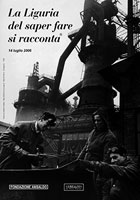The Project “La Liguria del saper fare si racconta”
Even the Gospels Come from Oral Sources
Why Do We Start from the Steel Industry in Cornigliano?
The Maritime-Port and Shipbuilding Sector
The Project “La Liguria del saper fare si racconta”
 Thanks to the support of the Compagnia di San Paolo, it has finally become possible to achieve a long-standing goal: our project “La Liguria del saper fare si racconta” is creating an audio-visual archives of entrepreneurship and work in this region. While the collection of the oral histories from various fields has already begun, a separate project is being planned to film the life stories and personal work histories as told by individuals from three areas that have been fundamental to the growth of the region: the steel industry, shipbuilding and the port. In addition, interviews are being set up with elderly individuals whose wealth of professional experience will become part of the archives’ legacy.
Thanks to the support of the Compagnia di San Paolo, it has finally become possible to achieve a long-standing goal: our project “La Liguria del saper fare si racconta” is creating an audio-visual archives of entrepreneurship and work in this region. While the collection of the oral histories from various fields has already begun, a separate project is being planned to film the life stories and personal work histories as told by individuals from three areas that have been fundamental to the growth of the region: the steel industry, shipbuilding and the port. In addition, interviews are being set up with elderly individuals whose wealth of professional experience will become part of the archives’ legacy.
The project, originating in Genoa, will be extended to the other three provinces of the region (Imperia, Savona and La Spezia) and will create a multimedia collection that vividly portrays Liguria’s productive characteristics. The high point is the opening of a room in the Ansaldo Foundation, equipped with advanced technology for preservation, collection and consultation of material. The history of work and business in Liguria will be accessible through a variety of research sources: from paper records to films, from photographs to oral testimonies. This initiative also intends to promote an intergenerational dialogue with high school students through a program of specific activities to be created jointly through two teachers’ associations (Cidi and Uciim). At the planning stage, we made use of the knowledge acquired in the employment of oral sources in both national and international contexts, clearly explained in Roberta Garruccio’s article, published in the second issue of this magazine.
I recently participated in two initiatives that gave me the opportunity to test the use of oral sources on a wide scale. At the first one, which took place during Genova 2004 capitale europea della cultura, I coordinated the thematic discussions which grew out of a series of keywords intended to solicit the participation of cultural associations.
One of these keywords was “recollection-memory” and the accounts of the work world (mostly from the mechanical engineering industry) were included in the chapter “factory” of the published book (
Genova 2004 in viaggio con le associazioni (edited by S. Vento), De Ferrari Editore, Genoa, 2004). We recorded many meetings and at the end of this period, we tape-recorded 160 individual and group interviews (89 women

and 71 men).
Since the discussions involved mostly older people, during the inquiry we paid particular attention to the presence of young people in associations (we interviewed 45 young people which represents 28% of the total). From this inquiry, we perceived a unanimously positive judgment on the pride of Genoa in displaying the wealth of its artistic and historic patrimony. Most of the interviewees expressed a desire for greater accessibility for the citizens to cultural institutions (in particular, they appreciated the street events and the periods when entrance to museums and historical buildings were free to the public). These interviews, semi-structured and qualitative, were conducted immediately following the event in order to capture the opinion of the citizen who participated. Now, at a distance of two years, we can say that the

interviews are part of the historical memory of the town.
My second experience refers to the TV program
Storie. Genova, la memoria, il futuro (on the air since January 2002 on the private Genoese channel Telecittà). At the beginning, I used some industrial films of the Ansaldo Foundation integrated with interviews with factory workers and managers, protagonists of the events narrated in the films so as to establish a dialectic between the present and the past. During periods of intense change, we become especially aware of the need to reflect on the past, to understand its connections with the present and especially, how recalling the past can help us create a better future.
Another part of the same program (38 episodes) was dedicated to the history of the areas where I found a large number of associations engaged in the valorization of cultural assets (monuments, churches, oratories, and other places) and eager to tell their respective stories.
Although the TV initiative’ original aims did not include the constitution of an archives, I collected (and showed on TV) such a large number of video-recorded oral testimonies that could be used to rebuild aspects of the history of a town or its own productive history and identity. There are plenty of opportunities for consulting both local business archives (if they are organized) as well as the great number of recorded interviews, since there are many private channels in every Italian region.
Maybe, the most complex task of the researcher is keeping track of the growing number of sources in scattered locations. I think it would be useful to establish a dialogue between the institutional archives and the other organizations that use oral testimonies for the development of their work. The material of the two initiatives described in this article (both the tapes of the registered interviews and the TV programs) are kept in the archives of the project
La Liguria del saper fare si racconta.
Apart from describing my direct experience, I would like to add a few theoretical considerations. The French anthropologist
Marc Augé proposed the term “
surmodernité” to indicate the current age, which is characterized by the production of too much information for the social researcher to work with. According to
Paola Carucci, the technical means, the aims and the productive conditions represent constitutive elements that condition the vast typology of oral sources. Above all, it is necessary to understand the context and the objectives of each single initiative, and to be aware of the “methodological polytheism”, that Pierre Bourdieu speaks about. This understanding and awareness should stimulate us to reflect continuously, without prejudice.
Even the Gospels Come from Oral Sources
|
 |
If we want to find some correspondence with the past, we can consider the extraordinary collection of oral sources represented by the gospels or by the Bible (always relevant, and not only for believers).
Jesus didn’t write anything himself; it was the four evangelists (Matthew, Mark, Luke, John) who transcribed the first oral testimony of the apostles. In Luke’s words: “Since many have undertaken to set in order a narrative concerning those matters which have been fulfilled among us, even as those who from the beginning were eyewitnesses and ministers of the word delivered them to us, it seemed good to me also, having traced the course of all things accurately from the first, to write….”
A large part of the preaching of the Bible prophets was also collected and transcribed by their disciples. The Talmud is an enormous archives of thousands of pages originally composed of the oral laws of the Jews, starting from the time of the Bible up to a thousand years later.
Why Do We Start from the Steel Industry in Cornigliano?
|
 |
Coming back to our project, the choice of starting the collection of stories from the steel industry work derives from the need to contextualize our activity in a place and period of change, such as that of Cornigliano, headquarters of the steelworks built in the early 1950s whose “hot working” area is now being dismantled. The reclaimed area will be given back to the town and the port to be reused in various ways.
From the beginning the factory of Cornigliano was managed according to criteria from the American model; many managers and technicians spent some periods in some American steel industries for a training period (especially in Armco Steel Corporation). One selected group of technicians of the shop “Times and Methods” spent a long period there to study systems of salary and compensation.
In the field of the industrial relations and communication, it is normal to experiment the most modern systems of that early period. Steel workers were classified according to a job evaluation, and many interviews were conducted in order to understand the degree of worker satisfaction. The company also implemented a series of actions aimed at bettering the social conditions of the workers.
- construction of subsidized housing
- recreation centers
- summer camps for the children
- corporate parties
- trips and excursions, also abroad
- presents to the children during particular festivities
 (Christmas, Epiphany...)
(Christmas, Epiphany...)
All these actions guaranteed a certain “social peace” that went on to the end of the 1960s. However, in December 1970, after a long and exhausting struggle, a union agreement concerning the integrated salary policy for workers and employees was signed, in this way overcoming the job evaluation system. This struggle modified the traditional schemes and was more intense than the one, much more famous, of the “hot autumn” (autunno caldo) of 1969. Moreover, it forced all corporate parties to reflect on a redefinition of work roles: from the simple job to the professionalism of every single worker.
External corporate communication has often usedmagazines (especially those with graphics by well-known artists) as well as theatrical, musical and cinematographic activities. Some of the artists and the intellectuals who have participated in this type of corporate communication include: Eugenio Carmi, Carlo Fedeli, Claudio Bertieri, Flavio Costantini, Lele Luzzati and Umberto Eco.
The Maritime-Port and Shipbuilding Sector
|
 |
This is a productive sector that lies at the heart of both the history and the image of Genoa; from the construction of the big transatlantic liners in the shipyard of Sestri Ponente to the amateur associations, the dock workers, and all those activities concerning the goods and the ships. Historically speaking, the moment of a ship’s launch represented the actual demonstration of the shipyard’s collective identity. It was the most exciting celebration and everybody – not just the governing authorities, the workers, the technicians and the managers with their families – but also an immense enthusiastic crowd of the general public. Nowadays, the shipyard continues to build big ships, no longer for Italian emigrants, but for cruise tourism.
The collection of oral histories will cover a wide variety of activities and we will reconstruct many work histories, including those of the officials and captains of the ships that marked the Italian Navy history. The triad “port, fleet, shipyard” will represent again a significant portion of the history of Genoa.

